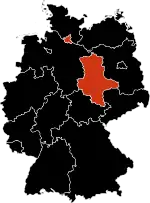2009 swine flu pandemic in Germany
The 2009 flu pandemic, involving an outbreak of a new strain of influenza commonly known as swine flu, reached Germany in April 2009.


Two men and a woman from Bielefeld who had been firstly suspected of having the virus tested negative on influenza type A.[1]
On 29 April, the first case of swine flu in Germany was confirmed by the Robert Koch Institute in the area of Regensburg.[2][3][4] A 22-year-old woman from Hamburg is also confirmed to have been infected by swine flu during a trip to Mexico.[4] A 37-year-old woman from Kulmbach is also confirmed to have become infected during a similar trip.[4]
| State | Confirmed cases |
Confirmed cases followed by death |
|---|---|---|
| Bavaria | 25,280 | 11 |
| North Rhine-Westfalia | 15,769 | 11 |
| Baden-Württemberg | 10,258 | 2 |
| Lower Saxony | 10,205 | 1 |
| Rhineland-Palatinate | 5,027 | 1 |
| Hesse | 4,130 | 1 |
| Saxony | 2,182 | 1 |
| Thuringia | 2,113 | 0 |
| Saxony-Anhalt | 2,050 | 0 |
| Hamburg | 2,034 | 0 |
| Berlin | 1,580 | 1 |
| Schleswig-Holstein | 1,476 | 0 |
| Brandenburg | 1,040 | 0 |
| Bremen | 866 | 0 |
| Mecklenburg-Vorpommern | 680 | 0 |
| Saarland | 600 | 1 |
| Total | 85,290 | 30 |
On 1 May, the Robert Koch Institute confirmed the first case of human-to-human transmission of swine flu in Munich. A nurse who had contact with one of the infected people was infected with the virus. At approximately 10:00 she was claimed to be already healed.[7] At 13:00 one additional infection in Bavaria was confirmed, but the patient was also claimed to be healthy again.[8]
On 2 May, a new human-to-human infection, in the same hospital in Munich, was confirmed. The new patient, who was in the same room with the original infected German that came from Mexico, is currently being reported to show no signs of the new influenza strain anymore.[9]
On 3 May, two further cases of swine flu in Brandenburg were reported. Two people from the same flight as patient in Hamburg were also infected.[10]
On 5 May, one new case in Saxony-Anhalt has been confirmed bringing to 9[11] the total number of people infected.
On 7 May, another new case in Saxony-Anhalt is reported.[12]
On 8 May, an adult male living in Bavaria who had recently been to United States.[13]
On 11 May, the case of a 27-year-old Bavarian woman, who stayed for some weeks in Mexico and medicated patients in a hospital, is reported.[14]
On 15 May, two more cases were reported, a female and her son from Saxony-Anhalt were obviously infected by her husband / his father, who returned from Mexico.[15]
On 21 May, a case was found in a 43-year-old woman from Düsseldorf in North Rhine-Westphalia who returned from New York.[16] One day later, Robert Koch Institute confirmed that her husband has been tested positive with swine influenza too. Furthermore, their six-year-old daughter, who did not stay in New York, has been infected by her parents, bringing the total to 17.[17]
Until 5 June 2009, the total number of confirmed cases increased to 49. Most of them have been recent travellers to Mexico, the US or the UK. However, there was also a single-digit number of (isolated) in-country-transmissions.
As of 6 November 2009, the number of infections increased to 29,900 with nine deaths caused by the flu.
References
- "Spiegel Online: Bielefeld - Entwarnung bei Schweinegrippe-Verdachtsfällen". Spiegel Online. 2009-04-27. Archived from the original on 29 April 2009. Retrieved 2009-04-27.
- "Spiegel Online: Erster Schweinegrippe-Fall in Deutschland". Spiegel Online. 2009-04-29. Archived from the original on 1 May 2009. Retrieved 2009-04-29.
- "Bavaria reports first case of swine flu in Germany". Reuters. Archived from the original on 4 May 2009. Retrieved 2009-04-29.
- "Virologen stellen drei Schweinegrippe-Fälle in Deutschland fest". Spiegel online. 2009-04-29. Archived from the original on 1 May 2009. Retrieved 2009-04-29.
- "Wochenberichte der AGI". Robert Koch-Institut. 2009-11-17. Archived from the original on 1 November 2009. Retrieved 2009-11-21.
- "Zur Situation in Deutschland". Robert Koch-Institut. 2009-11-19. Archived from the original on 2009-04-30. Retrieved 2009-11-21.
- "Spiegel Online: Erste Mensch-zu-Mensch-Infektion mit Schweinegrippe in Deutschland". Spiegel Online. 2009-05-01. Archived from the original on 3 May 2009. Retrieved 2009-05-01.
- "Spiegel Online: Virologen erwarten weitere Schweinegrippe-Infektionen in Deutschland". Spiegel Online. 2009-05-01. Archived from the original on 3 May 2009. Retrieved 2009-05-01.
- "Spiegel Online: Zweite Mensch-zu-Mensch-Infektion in Deutschland". Spiegel Online. 2009-05-02. Archived from the original on 4 May 2009. Retrieved 2009-05-02.
- "Schweinegrippe erreicht Brandenburg". Focus Online. 2009-05-03. Retrieved 2009-05-03.
- "Spiegel Online: Neunter Schweinegrippe-Fall in Deutschland". Spiegel Online. 2009-05-05. Archived from the original on 8 May 2009. Retrieved 2009-05-05.
- "Welt Online: Zehnter Fall von Schweinegrippe in Deutschland". Die Welt. Welt Online. 2009-05-07. Archived from the original on 10 May 2009. Retrieved 2009-05-07.
- "Spiegel Online: ZH1N1-Virus erstmals aus den USA eingeschleppt". Spiegel Online. 2009-05-08. Archived from the original on 10 May 2009. Retrieved 2009-05-08.
- "Welt Online: Zwölfter deutscher Schweinegrippe-Fall bestätigt". Die Welt. Welt Online. 2009-05-11. Archived from the original on 14 May 2009. Retrieved 2009-05-12.
- "Welt Online: Zwei neue Schweinegrippe-Fälle in Deutschland". Die Welt. Welt Online. 2009-05-15. Archived from the original on 17 May 2009. Retrieved 2009-05-17.
- "Welt Online: Düsseldorferin an Schweinegrippe erkrankt". Die Welt. Welt Online. 2009-05-20. Archived from the original on 22 May 2009. Retrieved 2009-05-21.
- "Situationseinschätzung zur Neuen Influenza (Situation assessment to the new influenza)" (in German). 2009-05-22. Archived from the original on 2009-05-21. Retrieved 2009-05-22.